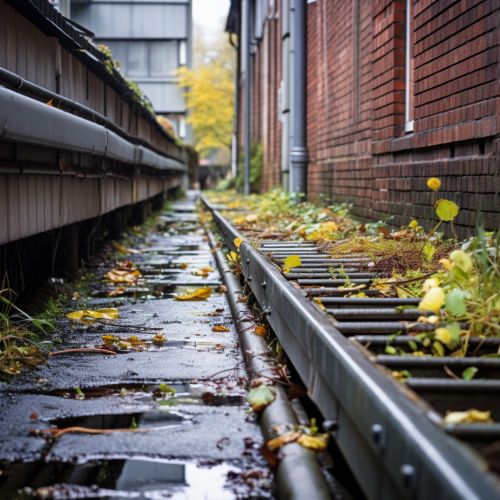Surface drainage
Introduction
Surface drainage is the process by which water on the ground surface is removed. It is a critical aspect of water management strategies, particularly in areas prone to flooding or with high levels of precipitation. The primary purpose of surface drainage is to prevent water accumulation and saturation, which can lead to various problems such as soil erosion, waterlogging, and damage to structures.
Types of Surface Drainage Systems
There are several types of surface drainage systems, each designed to suit specific conditions and requirements. These include:
- Open Ditch Systems: These are simple, cost-effective systems that involve the creation of open channels or ditches to carry water away from the area. The ditches are typically sloped to facilitate water flow.
- Subsurface Drainage Systems: These systems involve the installation of pipes or drains below the ground surface to collect and carry away water. Subsurface drainage systems are often used in agricultural fields to prevent waterlogging and improve soil conditions.
- Roadside Drainage Systems: These systems are designed to remove water from roads and highways to prevent flooding and maintain safe driving conditions. They typically involve a combination of gutters, ditches, and culverts.
- Urban Drainage Systems: Urban drainage systems are complex networks of gutters, pipes, and drains designed to manage stormwater runoff in urban areas. They play a crucial role in preventing flooding and maintaining the integrity of urban infrastructure.


Design and Construction of Surface Drainage Systems
The design and construction of surface drainage systems require careful planning and consideration of various factors. These include the topography of the area, the type and amount of precipitation, the characteristics of the soil, and the intended use of the land.
- Topography: The natural slope and contour of the land play a crucial role in the design of surface drainage systems. Water naturally flows downhill, so the system must be designed to take advantage of this.
- Precipitation: The type and amount of precipitation in the area will determine the capacity required for the drainage system. Areas with high rainfall will require larger, more robust systems.
- Soil Characteristics: The type of soil in the area can affect the efficiency of the drainage system. For example, sandy soils have high permeability and can absorb more water, reducing the need for extensive drainage systems. On the other hand, clay soils have low permeability and may require more complex systems.
- Land Use: The intended use of the land can also influence the design of the drainage system. For example, agricultural fields may require different drainage solutions compared to urban areas or roads.
Maintenance of Surface Drainage Systems
Regular maintenance is crucial to ensure the effective operation of surface drainage systems. This typically involves regular inspections to identify and address any issues such as blockages, damage, or erosion. In addition, vegetation control may be necessary in some cases to prevent roots from blocking the drains.
Environmental Impact of Surface Drainage
While surface drainage is essential for water management, it can also have significant environmental impacts. These include changes to the natural water cycle, loss of wetland habitats, and increased pollution from stormwater runoff. Therefore, it is crucial to consider these impacts during the design and implementation of surface drainage systems and to incorporate sustainable drainage practices where possible.
